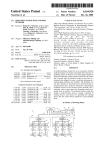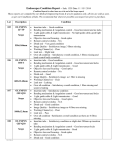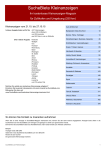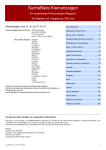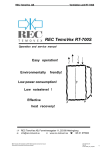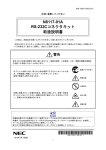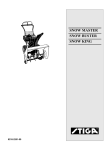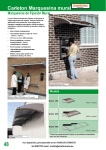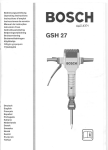Download (2“ 1
Transcript
USOO5813972A Ulllted States Patent [19] [11] Patent Number: Nazarian et al. [45] [54] [75] 5,813,972 Date of Patent: Sep. 29, 1998 MEDICAL PERFUSION SYSTEM WITH 5,572,658 DATA COMMUNICATIONS NETWORK 5,609,770 3/1997 Zimmerman et 91 5,622,429 4/1997 5,627,531 5/1997 Posso et al. ............................ .. 341/22 Timothy Kriewall, Castle Rock, Colo.; Richard A. Griewski, Canton 0 609 688 0 690 291 8/1994 3/1996 European Pat. Off. ...... .. G06F 15/42 European Pat O?- - Township Nlich~ ’ O 745 348 O 748 609 12/1996 12/1996 European Pat. Off. ........ .. A61B 5/00 European Pat. Off. A61B 5/00 Inventors: Richard A_ Nazarian, Golden Valley; 11/1996 Mohr et al. ...................... .. 395/18202 HeinZe .............. .. .. Watts, Woodbury, all of M1nn.; . _ . . . [73] Asslgnee' xmnefsotta Mlmgg and M?“ ac “nng S P 1 ompany’ L au> O 762 815 3/1997 0 768 060 4/1997 European Pat. Off. European Pat. Off. 24 55 229 5/1976 . HO5K 5/00 .. A61B 5/215 Germany ...................... .. A61M 1/03 mn. OTHER PUBLICATIONS [21] Appl' NO‘: 723’504 [22] Filed: Sep. 30, 1996 Jostra HL20 User’s Manual, Jostra AB, Sweden, 120 pages, undated 6 Jostra HL20 Technical manual, sep. 9, 1994, 46 pages. [51] Int. Cl. .................................................... .. A61M 1/00 [52] US. Cl. .............................................................. .. 600/17 [58] Field of Search ................................ .. 600/17,6(1)2;2183; (List Continued on next page) Primary Examiner_w?ham E‘ Kamm ’ [56] Assistant Examiner—Kennedy J. SchaetZle References Cited Attorney, Agent, or Ftrm—Gary L. Grlswold; Stephen W. Bauer; Martm J. Hlrsch [57] ABSTRACT U.S. PATENT DOCUMENTS 4,722,224 2/1988 Scheller et al. ......................... .. 5,001,642 3/1991 BOtZenhardt et a1_ 5,059,167 10/1991 Lundquist et a1, 73/599 _ 364/431_12 ____ __ 600/17 _ _ _ _ A medical perfusion system for use in connection w1th the medical treatment of a patient is provided with a ?rst type of 5,105,441 4/1992 Borst et al. ......... .. 375/17 perfusion device in the form of a blood pump adapted to 5,111,460 5/1992 Botlenhardt et al- 371/29 1 pump blood through a ?uid conduit connected to the patient, 572167674 6/1993 Pet?“ a1~ ~~~~~~~~~~ ~~ 371/29 5 a second type of perfusion device in the form of a sensor 2222410 6/1993 Holzmierdet a1‘ 5,341,497 8/1994 303348 27/445‘ 4/1994 Botzen at tet a‘ Younger .......... .. 573877122 2/1995 Goldberger et aL __ 5,444,626 5,448,180 8/1995 Schenk ____________ __ 9/1995 Kienzler et a1, 5,448,561 5,493,515 9/1995 Kaiser et al. 2/1996 Bat§heldef et a1- -- 5:499:36 3/1996 Prels ct a1~ ~~~~~~ ~~ , i/i‘bler et a1‘ , ayer through the ?uid conduit and to generate a sensing signal 395/575 573577518 10/1994 Peter ___________ n 2’; adapted to sense a condition relating to the pumping of blood 39 62 1 . . . . . . . . 5,539,778 7/1996 KienZler et al. .. d. . d d work for operat1vely mterconnectmg the perfusion devlces. The perfusion system also includes means for transmitting messages in the form of digital data packets among the 370/85 1 364/550 perfusion devices over the data communications network and a controller operatively coupled to the perfusion devices 395/182 02 via the data communications network, the controller having an input device for accepting pump control commands - u 39500017 relatmg to the blood pump from an operator. 375/317 15 Claims, 15 Drawing Sheets MAIN —~2o CONTROLLER 10 30L % 30k 1 HT EXTENDER CONTROLLER 30b 409 52g EXTENDER 325 CONTROLLER 32b 30: ll [34a NODE CONTROLLER and a: 40a 314b NODE CONTROLLER 306 w 40b u 309 341: J 34d NODE CONTROLLER NODE CONTROLLER 3 0' 400 30h 34 e NODE CONTROLLER 3 Di /34f NODE CONTROLLER 3 0l @ 40f 2f TEMPERATURE SENSOR 50a . 439/353 5,564,108 10/1996 Hunsaker et al. .................... .. 395/800 (2“ . a 'ata COIIIIIIUHICZIIIOHS'HCI 364/431_04 ____ __ 326/15 . . . . . . . . .. 6/1996 Dais et a1‘ ' h re atmg to t e con 1t1on, an 364/ 575247213 . 371/11 2 50s 501 5,813,972 Page 2 OTHER PUBLICATIONS Cobe/Stockert Perfusion System, Technical Handbook, Cobe Laboratories, Inc., Rev. A, pp. 1—1—1—33; 2—1— SarnsTM 9000 Perfusion System Operators Manual, Sep. 1995, pp. i—v; A—C; 1.1—1.11;2.1—2.11;3.1—3.11;4.1—4.10; 2—66; 3—1—3—93; 4—1—4—105; and 5—1—5—29, undated 5.1—5.7; 6.1—6.9; 7.1—7.6; 8.1—8.6; 9.1—9.4; 10.1—10.4; 11.1—11.3; 12.1—12.4; 13.1—13.2; 14.1—14.3; 15.1; 16.1—16.4; 17.1—17.14; 18.1—18.6; 19.1—19.19; 20.1—20.56, S 3 System, HerZ—Lungen—Maschine irn Modularsystern, GebrauchsanWeisung, Table of Contents, pp. I—XXI; pp. including Additional insert, 4 sheets; and IndeX, pp. 21.1—21.4. 3MTMSarnsTM Modular Perfusion System 8000 Operators Manual, May 1996, pp. i—v; 1.1—1.22; 2.1—2.14; 3.1—3.10; 4.1—4.10; 5.1—5.2; 6.1—6.2; 7.1—7.5; 8.1—8.4; 9.1—9.9; 10.1—10.68; and IndeX, pp. 11.1—11.3. (prior art). 1—1—1—2; 2—1—2—28; 3—1—3—14; 4—1—4—22; 5—1—5—262; 6—1—6—22; 7—1—7—8; 8—1—8—16; A—1— A—18, undated. “BOC Puts Ohrneda Health Care Business Up for Sale”; Medical Devices, Diagnostics & Instrurnentation Reports The Gray Sheet; vol. 23, No. 30; Jul. 28, 1997. U.S. Patent Sep.29,1998 Sheet 2 0f 15 5,813,972 40 70 82 4. 7O @ 7O 86 68 FIG. 2 FIG. 4 F|G.3 FIG. 5 62 409 40h 6930 0 4Oc122u a a 54 % 40d L; y_ 4Oe /1/ 40b / 84 v 0 0 ¢ o o o 0 FIG. 6 72‘86 74 76 ¢ 84 F|G.7 88 U.S. Patent Sep.29,1998 20 (100 Sheet 3 0f 15 102 104 \ MP 11a 283E: NON VOLATILE RAM MEMORY * i ‘F i NETWORK DRAWING CONTROL- CONTROL- LER LER l \10s 120 5,813,972 "\112 (114 -> DISPLAY l/O ( \103 ( INPUT 110 /30m 341 g NODE CONTROLLER H 134h NODE CONTROLLER ?~3oa 116 U /341 /34] NODE CONTROLLER NODE CONTROLLER ?\3Oc ?\30d ?\30b 32a \ 135 133 DRIVER T 30a CONTROLLER —> sw ##132 130/ 134 134 FIG. 10 30C U.S. Patent Sep.29,1998 Sheet 4 0f 15 5,813,972 34a ENABLE/ DISABLE \ DATA /134 +24V —--152 CODE ___..144 150 154 +5V r120a -120b 152 158 - I—) _» GND ~120c 164 1 SW CONTROLLER ) ' l‘\ f'\ 1 \14o Y <--OR|vER ~_ 170 -——120a r--12ob ———-“2°¢ #133 DATA +24 +5 GND 40a DATA 133 |'-152 1 4 f DRIVER T +24v +5v GND XCVR i f 120a \ 120!) 186 POWER CONTROLLER 180/ T __120c SUPPLY ——~ t MEMQRY DEVICE / INTERFACE 192 194 FIG. 12 182 U.S. Patent Sep. 29, 1998 5,813,972 Sheet 5 0f 15 / 200 CONFIGURE I 204 SELECT FILE SELECT TYPE OF PERFUSION CIRCUIT / DISPLAY / 208 PERFUSION CIRCUIT SELECT oPTIoN / 21° 226 ADD DEVICE? CONFIGURE DEVICE? / SELECT DEVICE TYPE / DISPLAY CURRENT CONFIGURATION l / 216 l /224 SELECT POSITION CHANGE CONFIGURATION I DISPLAY DEVICE IN PERFUSION CIRCUIT /21s I FIG. 13A DISPLAY DATA? 228 DATA AVAILABLE? /230 DISPLAY DATA No U.S. Patent Sep.29,1998 Sheet 6 0f 15 5,813,972 260 AUTO MODE? ONLY ONE MATCH? Yes SELECT ALREADY CONFIGURED? CONFIGURATION __> 274 CONFIGURE DEVICE / 276 I SELECT POSITION POSITION KNOWN? _/ 263 DISPLAY DEVICE IN / 270 PERFUSION CIRCUIT FIG. 13B U.S. Patent Sep.29,1998 Sheet 7 0f 15 5,813,972 [280 DECODE DEVICE TYPE AND PHYSICAL ADDRESS 284 FULL POWER? Yes ALLOCATE LOGICAL ADDRESS / 286 V ENCODE STARTUP / 288 GRANTED MESSAGE V TRANSMIT MESSAGE / 29° 292 LOCAL DEV ICE? Y es / 294 ENABLE POWER VIA LOCAL NODE CONTROLLER ENCODE NODE ENABLE MESSAGE V TRANSMIT MESSAGE / 298 FIG. 13C U.S. Patent Sep.29,1998 Sheet 8 0f 15 5,813,972 300 / STATUS REQUEST . 33o ENCODE STATUS REQUEST MESSAGE / 302 BROADCAST STATUS / 304 \\ REQUEST MESSAGE * 306 START TIME-OUT / PERIOD H G- 1 3D DISCONNECT VIA LOCAL NODE CONTROLLER / 310 I RECEIVE STATUS $6 DETERMINE LOGICAL ADDRESS / 312 FROM STATUS MESSAGE I DETERMINE STATUS FROM MESSAGE / s14 ENCODE DISCONNECT MESSAGE l /338 TRANSMIT MESSAGE 316 STATUS OK? RESPOND TO STATUS CONDITION G. 1 3F @3 FIG. 13E U.S. Patent Sep. 29, 1998 Sheet 9 0f 15 5,813,972 [350 352 CONTROL COMMAND? ENCODE CONTROL MESSAGE /354 T BROADCAST CONTROL MESSAGE RESET ALARM? ENCODE ALARM RESET MESSAGE / 360 + BROADCAST ALARM / 362 RESET MESSAGE RESET SYSTEM? ENCODE SYSTEM RESET MESSAGE / 366 BROADCAST SYSTEM / RESET MESSAGE FIG. 136 368 U.S. Patent Sep.29,1998 Sheet 10 0f 15 5,813,972 / 370 UPDATE DISPLAY _) LOG EVENT 374 UPDATE DISPLAY 37s ‘’ 380 STARTUP ——> 382 PROCESS UPDATE MESSAGE + DISPLAY 386 REQUEST? LOG DATA ass PROCESS _) UPDATE REQUEST DISPLAY 394 LOG _> \ 396 FIG. 13H STATUS 39o _“) U.S. Patent Sep.29,1998 Sheet 11 0f 15 5,813,972 FIG. 14A FIG. 14B U.S. Patent Sep. 29, 1998 Sheet 12 0f 15 CEXTENDER STARTUP) PERFORM INTERNAL SELF-TESTS 424 5,813,972 / 420 / 422 No Yes TEST BUS -/' 426 42s No Yes START PERIODIC TRANSMISSION To NODE CONTROLLER BROADCAST / 43o ERROR MESSAGE ‘ * WAIT FOR \ PHYSICAL ADDRESS 436 / 432 434 ALL TESTS PASSED? BROADCAST STARTUP REQUEST _/ 438 WAIT FOR STARTUP GRANTED MESSAGE / 44° WAIT FOR FULL POWER / 442 MEASURE vOLTAGES / 444 AND CURRENT 446 N 0 Yes FIG. 1 5A U.S. Patent Sep.29,1998 / DECODE PHYSICAL ADDRESS OF MESSAGE / 452 Sheet 13 0f 15 5,813,972 DISCONNECT DECODE PHYSICAL ADDRESS OF MESSAGE 454 464 No Yes 456 / 462 NO Yes 4266 TRANSMIT ENABLE SIGNAL TO NODE CONTROLLER TRANSMIT DISABLE SIGNAL To NQDE CONTROLLER FIG. 158 FIG. 15C U.S. Patent Sep. 29, 1998 5,813,972 Sheet 14 0f 15 470 CODE VALID? Yes / RESTART TIME-OUT TIMER 490 476 / TRANSMIT PHYSICAL ADDRESS 478 / CONNECT DEVICE TO DATA BUS DISCONNECT DEVICE / 492 FROM DATA BUS I ENABLE? DISCONNECT DEVICE / 494 FROM FULL POWER SUPPLY FULL POWER TO DEVICE FIG. 16B DISCONNECT DEVICE FROM DATA BUS W [486 DISCONNECT DEVICE FROM FULL POWER FIG. 16A U.S. Patent Sep.29,1998 Sheet 15 0f 15 52 o\ C POD STARTUP D 550\ 5,813,972 I DECODE MESSAGE PERFORM INTERNAL 522 / SELF-TESTS 552 v 524 N° TRANSMIT CONTROL SIGNAL TO DEVICE 554 / Yes 526 _/ i) TEST BUS 528 FIG. 1 7B 560 N° 530 Yes,__,/ START PERIODIC @ TRANSMISSION To BROADCAST NoDE coNTRoLLER ERROR MESSAGE ENCODE ALARM MESSAGE V A WAIT FOR \ 562\ / 532 T PHYSICAL ADDRESS 536 BROADCAST ALARM MESSAGE f 564 ALL TESTS PASSED? 570 538 \ BROADCAST STARTUP REQUEST 540 \ WAIT FOR STARTUP GRANTED MESSAGE * 542 \ @ 572 \ WAIT FOR FULL POWER + 544\ FIG. 17C ' SIGNAL * 574 \ ENCODE MESSAGE WITH SENSING SIGNAL MEASURE voLTAGES AND CURRENT READ SENS'NG Y 576 \ BROADCAST MESSAGE FIG. 17D 5,813,972 1 2 MEDICAL PERFUSION SYSTEM WITH DATA COMMUNICATIONS NETWORK In another aspect, the invention is directed to an adapter pod for use in a medical perfusion system having a data communications netWork With a plurality of connection points each having a substantially identical netWork con nector. The adapter pod includes a common connector adapted to be connected to one of the netWork connectors, a device connector adapted to be connected to a perfusion device, and means for generating a message in the form of BACKGROUND OF THE INVENTION The present invention is directed to a medical perfusion system adapted to handle the selective oxygenation, ?ltering and recirculation of blood in connection With various medi cal procedures. A conventional perfusion system may be used to oxygenate, ?lter, and/or recirculate the blood of a patient during a medical procedure. Such a perfusion system may 10 to those of ordinary skill in the art in vieW of the detailed have a ?uid conduit that removes blood from the patient description of the preferred embodiments, Which is made during the medical procedure, a separate ?uid conduit that With reference to the draWings, a brief description of Which returns blood to the patient, one or more blood pumps that pump blood through the conduits, and a plurality of sensing a digital data packet. These and other features of the invention Will be apparent is provided beloW. 15 devices, such as How sensors and/or level sensors associated BRIEF DESCRIPTION OF THE DRAWINGS With blood pumps. The perfusion system may also include air embolus sensors, temperature sensors, ?oW occluders, FIG. 1 is a block diagram of a preferred embodiment of a perfusion system in accordance With the invention; FIG. 2 is a perspective vieW of the main controller shoWn etc. Typically, a perfusion system is provided With a con?gu ration speci?cally designed to be used for a particular purpose. For example, one perfusion system may be spe ci?cally designed as a full-function heart/lung machine, schematically in FIG. 1; FIG. 3 is a perspective vieW of one of the netWork extenders shoWn schematically in FIG. 1; While another perfusion system may be speci?cally designed as a ventricular-assist system. Although it may be possible to FIG. 4 is a perspective vieW of one of the adapter pods 25 convert a perfusion system designed for one purpose to a perfusion system usable for a different purpose, such recon shoWn schematically in FIG. 1; FIGS. 5—7 illustrate a number of connector con?gura tions; ?guration is generally difficult and/or time-consuming. FIG. 8 is a perspective vieW of the main controller shoWn schematically in FIG. 1 With tWo netWork extenders and SUMMARY OF THE INVENTION The invention is directed to a medical perfusion system for use in connection With the medical treatment of a patient. eight adapter pods plugged therein; The perfusion system includes a ?rst type of perfusion schematically in FIG. 1; device in the form of a blood pump adapted to pump blood through a ?uid conduit connected to the patient, a second type of perfusion device in the form of a sensor adapted to sense a condition relating to the pumping of blood through FIG. 9 is a block diagram of the main controller shoWn FIG. 10 is a block diagram of one of the extender 35 controllers shoWn schematically in FIG. 1; FIG. 11 is a block diagram of one of the node controllers shoWn schematically in FIG. 1; the ?uid conduit and to generate a sensing signal relating to FIG. 12 is a block diagram of one of the adapter pods the condition, and a data communications netWork for operatively interconnecting the perfusion devices. The per shoWn schematically in FIG. 1; fusion system also includes means for transmitting messages FIGS. 13A—13H are ?oWcharts illustrating the operation of the main controller shoWn in FIG. 1; FIGS. 14A—14B are exemplary illustrations of a pair of in the form of digital data packets among the perfusion devices over the data communications netWork and a con troller operatively coupled to the perfusion devices via the data communications netWork, the controller having an input device for accepting pump control commands from an 45 FIGS. 15A—15C are ?oWcharts illustrating the operation of the extender controllers shoWn in FIG. 1; FIGS. 16A—16B are ?oWcharts illustrating the operation of the node controllers shoWn in FIG. 1; and FIGS. 17A—17D are ?oWcharts illustrating the operation of the adapter pods shoWn in FIG. 1. operator. The data communications netWork may be provided With a plurality of netWork connectors, each of Which has an identical connector con?guration, and the perfusion system may include at least tWo adapter pods, each of Which has a common connector adapted to be coupled to one of the netWork connectors and a device connector adapted to be coupled to one of the perfusion devices. The message transmitting means may include means for generating a 55 message containing a control command for the pump and means for generating a message containing data relating to the sensed condition. The controller may include a plurality of netWork connectors, and the data communications netWork may connectors. DETAILED OF THE PREFERRED EMBODIMENTS FIG. 1 illustrates a preferred embodiment of a medical perfusion system 10 in accordance With the invention. The perfusion system 10 is adapted to handle the selective oxygenation, ?ltering and recirculation of blood in connec tion With a number of different medical procedures. The perfusion system 10 may be placed in a number of different con?gurations, each of Which corresponds to a different include a netWork extender having a netWork connector adapted to be coupled to one of the netWork connectors of the controller, a plurality of extender connectors adapted to be connected to the common connectors of the adapter pods, and a data bus electrically interconnecting the netWork connector of the netWork extender With each of the extender perfusion circuit images generated on the display device of FIG. 9 during operation of the perfusion system; medical procedure. For example, the perfusion system 10 65 may be con?gured as a full-function heart/lung machine, a ventricular assist system, or a single-pump system that can be used for various purposes, such as to perform blood aspiration or myocardial protection during surgery. 5,813,972 4 3 Referring to FIG. 1, the main controller 20 is connected pod 40 has a hexahedral housing With one side 82 on Which a connector 84 is disposed and an opposite side on Which a connector 86 is disposed. The connector 86 is identical to the to a netWork extender 22a via a data/poWer bus 30a and to a netWork extender 22b via a data/poWer bus 30b. The netWork extender 22a includes an extender controller 32a connected to three node controllers 34a, 34b, 34c via a data/poWer bus 30c. The node controller 34a is connected via a data/poWer bus 30a' to an adapter pod 40a, Which is in turn connected to a perfusion device 50 in the form of a How sensor 50a via a bidirectional data/poWer line 52a. The node controller 34b is connected via a data/poWer bus 306 to an adapter pod 40b, Which is connected to an air embolus connectors 72 described above (and shoWn in FIG. 6). The connector 84 is adapted to be connected to a device 10 sensor 50b via a bidirectional line 52b. The node controller different type of perfusion device 50 (the pumps 50c, 50g 34c is connected via a data/poWer bus 30f to an adapter pod may be different types of pumps, such as a roller pump or a 40c, Which is connected to a blood pump 50c via a bidirec tional line 52c. The netWork extender 22b includes an extender controller 32b connected to three node controllers 34d, 34e, 34f via a 15 connected to a pressure sensor 50d via a bidirectional line pods 40, it should be noted that any of the adapter pods 40 52d. The node controller 346 is connected via a data/poWer bus 30i to an adapter pod 406, Which is connected to a may be plugged into any of the connectors 60, 70. As a result, any combination of perfusion devices 50 may be temperature sensor 506 via a bidirectional line 526. The node connected to the main controller 20. controller 34f is connected via a data/poWer bus 30j to an 25 via a bidirectional line 52]”. The main controller 20 is operatively coupled to a blood pump 50g via a bidirectional line 52g connected to an designed to be used in a medical perfusion system, including but not limited to a blood pump such as a centrifugal or roller pump, a ?oW sensor, a pressure sensor, a temperature sensor, a level sensor, an air embolus sensor or an occluder. Mechanical Structure of Network Components FIG. 2 is a perspective vieW of a portion of one mechani cal embodiment of the main controller 20. Referring to FIG. 2, the main controller 20 has four netWork connectors 60, FIG. 8 illustrates the main controller 20 having the netWork extenders 22 and the adapter pods 40 connected to it. Each of the adapter pods 40 of FIG. 8 Would be connected to a respective one of the perfusion devices 50 shoWn in FIG. adapter pod 40g. The pod 40g is connected to the main controller 20 via a data/poWer bus 30k. The main controller 20 is operatively coupled to a level sensor 50h via a bidirectional line 52h connected to an adapter pod 40h, Which is connected to the main controller 20 via a data/ poWer bus 301. As used herein, the term “perfusion device” is a device centrifugal pump), the connector 84 disposed on each of the adapter pods 40 may have a different connector con?gura tion. Since the connectors 60 of the main controller 20 and the connectors 70 of the netWork extenders 22 have the same connector con?guration as the connector 86 of the adapter data/poWer bus 30g. The node controller 34a' is connected via a data/poWer bus 30h to an adapter pod 40d, Which is adapter pod 40f, Which is connected to a How occluder 50f connector (not shoWn) that is associated With one of the perfusion devices 50 described above. The connector 84 has a different connector con?guration than the connectors 60, 70, 72, 86. One example of the structure of the connector 84 is shoWn in FIG. 7 to include six conductive pins 88. Since each of the adapter pods 40 is adapted to be connected to a 35 1 via a respective connector (not shoWn) attached to the perfusion device 50 by a cable. Although the form of the netWork extenders 22 shoWn in FIGS. 3 and 8 makes the resulting control unit compact, netWork extenders having different structures could be used. For example, instead of having the connector 72 ?xed on the housing 66, the connector 72 could be connected to the housing 66 via a cable. Alternatively, the housing 66 could be eliminated, and the connectors 70, 72 could be intercon nected via cables. Electronics FIG. 9 is a block diagram of the main controller 20 shoWn schematically in FIG. 1. Referring to FIG. 9, the main controller 20 has a microprocessor (MP) 100, a random access memory (RAM) 102, a nonvolatile memory 104 such Which are shoWn schematically. Each of the netWork con 45 as a hard disk or a ?ash RAM, a netWork controller 106, a draWing controller 108, and an input/output (I/O) circuit nectors 60 is identical and has the same connector con?gu 110, all of Which are interconnected by an address/data bus ration. FIG. 5 illustrates the structure of the connectors 60. 112. The U0 circuit 110 is connected to a display device 114, As shoWn in FIG. 5, each connector 60 may be, for example, a standard personal computer connector having nine con such as a CRT or a ?at-panel display, and an input device ductive pins 62 partially surrounded by an asymmetrical metal housing 64. screen on the display device 114. 116, such as a keyboard or electronic mouse or a touch FIG. 3 is a perspective vieW of one embodiment of the The main controller 20 also includes a poWer supply netWork extenders 22 shoWn schematically in FIG. 1. Each circuit 118 that is connected to an outside source of AC netWork extender 22 has a hexahedral housing 66 With one poWer and Which includes an internal transformer (not side 68 on Which three connectors 70 are disposed and an 55 shoWn) that generates +5 volt and +24 volt DC poWer on a opposite side on Which a connector 72 is disposed. Each pair of electrical poWer lines relative to a ground line, Which connector 70 is identical to the connectors 60 and has the lines are schematically designated 120 in FIG. 9. The structure shoWn in FIG. 5. The connector 72, Which is shoWn electrical poWer and ground lines 120 are provided to each in FIG. 6, has nine pin receptacles 74 formed in an asym metrical housing 76 composed of an insulating material such as plastic. The pin receptacles 74 are located to correspond to the positions of the nine pins 62 of the connector 60. of four node controllers 34g—34j via a data/poWer bus 30m and to the other node controllers 34 via the other portions of the netWork bus 30. The data/poWer bus 30m includes a FIG. 4 is a perspective vieW of the adapter pods 40 shoWn schematically in FIG. 1. Referring to FIG. 4, each adapter controllers 32a, 32b is the same). Referring to FIG. 10, the number of data communication lines Which are connected to the netWork controller 106. Consequently, the connector 72 has the same connector con?guration as the connector 60 and thus can be plugged FIG. 10 is a block diagram of the extender controller 32a into the connector 60. 65 shoWn schematically in FIG. 1 (the design of the extender extender controller 32a has a controller 130 and a sWitch 5,813,972 6 5 132, both of Which are connected to the data/poWer bus 30a. The extender controller 32a is connected to its parent node controller 34g via a bidirectional signal line 133. As used herein, a “parent” device is a connected device that is closer Depending on the type of perfusion device 50 to Which an adapter pod 40 is connected, the signals on the data lines 192 might include, for example, digital or analog signals (e.g. 4—20 ma signals) relating to the control of the perfusion to the netWork controller 106 (FIG. 9) of the main controller 20. The node controller 34g transmits a unique physical address to the extender controller 32a via the line 133, and device 50, such as a desired pump speed or mode of operation. The number of data lines 192 used depends on the particular perfusion device 50 to Which the adapter pod 40 the extender controller 32a includes a driver circuit 135 Which is used to periodically transmit a check-in code to the node controller 34g via the line 133. The check-in code and the physical address may be the same binary code. FIG. 11 illustrates a block diagram of the node controller 10 is connected. The controller 180 also causes various types of electrical poWer to be transmitted to the perfusion device 50 via the poWer lines 194. These types of poWer include, for example, +5 volt DC poWer or +24 volt DC poWer. If poWer of another 34a shoWn schematically in FIG. 1 (the design of all the node controllers 34 is the same). Referring to FIG. 11, the voltage level is necessary, the poWer supply circuit 182 may enable signal or a disable signal from the extender controller 32a via one of the lines 134 and a periodic check-in code Con?guration and Display of Perfusion Circuit node controller 34a has a controller 140 Which receives an 15 comprise a DC/DC converter. from the adapter pod 40a via the line 133. The controller 140 Prior to using the perfusion system 10 for a medical is connected to a code generator 144 via a multi-signal line procedure, the operator connects the desired perfusion 146. The code generator 144 generates a predetermined devices 50 to the main controller 20 by physically connect multi-bit binary code that uniquely speci?es the physical ing the desired adapter pods 40 and/or netWork extenders 22 address of the node controller 34a. The code generator 144 may be, for example, a number of printed metal circuit lines, one line for each bit of the code, each line being selectively to the main controller 20, as shoWn in FIG. 8. Prior to the commencement of a medical procedure, the perfusion system 10 is con?gured during a con?guration connected either to +5 volts (logic “1”) or to ground (logic process illustrated in FIG. 13A, Which is a ?oWchart of a “0”). 25 either connects or disconnects a data bus 152, Which may be composed of tWo individual data lines, that is part of the data/poWer buses 30c, 30d (and the other buses 30 that make ?le generally includes image data corresponding to an image up the network). When the sWitch 150 is open, the data buses 30c, 30d are disconnected, and When the sWitch 150 is closed, the buses 30c, 30d are connected to enable data of a perfusion circuit, Which may include an outline of the communications betWeen the adapter pod 40a and the other devices connected to the netWork 30. The controller 140 also operates a sWitch 154 that controls 35 Whether +24 volt DC poWer (relative to a ground line 1206) on a electrical poWer line 120a is supplied to the adapter pod represented by a different image, depending upon the type of perfusion device. For example, pumps may be represented different image. The con?guration ?le may also include data relating to the perfusion devices 50, such as the manufacturer and model number of the device, the desired operational mode of the adapter pod 40a. The electrical poWer lines 120a, 120b are part of the data/poWer buses 30c, 30d and the other buses 30 device, numeric limits at Which an alarm should be triggered, and identi?cation of any associated perfusion 45 current-limiting resistors Which prevent large amounts of current from being draWn from the poWer lines 120a, 120b When the sWitches 154, 158 are open. The controller 140 is connected to a driver circuit 170 Which is used to transmit the physical address generated by the code generator 144 to the adapter pod 40a via the line 133. FIG. 12 illustrates a block diagram of the adapter pod 40a shoWn schematically in FIG. 1. Referring to FIG. 12, the adapter pod 40a has a controller 180 Which is poWered by a poWer supply 182 connected to the electrical poWer lines 120a, 120b. The controller 180 may transmit a check-in code patient, images of a plurality of ?uid conduits connected to the patient, and images of the various perfusion devices 50 used in the system 10. Each perfusion device 50 may be by a pump image, Whereas a How sensor may have a 40a and a sWitch 158 that controls Whether +5 volt DC poWer on an electrical poWer line 120b is supplied to the that make up the netWork. A resistor 162 is connected in parallel With the sWitch 154, and a resistor 164 is connected in parallel With the sWitch 158. The resistors 162, 164 act as con?guration computer program routine 200 executed by the main controller 20. Referring to FIG. 13A, at step 202 the program generates a visual prompt to the operator to request Whether a previous con?guration ?le should be loaded from the memory 104 of the main controller 20. A con?guration The controller 140 selectively operates a sWitch 150 that device. TWo perfusion devices may be “associated” if one device that is used to control a physical process, referred to herein as a control device, is to receive feedback from another perfusion device, referred to herein as a sensing device. For example, referring to FIG. 1, the pump 50g could be controlled based on feedback generated by either the level sensor 50h (Which Would generate a signal indicative of ?uid level Within a ?uid reservoir) or the How sensor 50a. In the 55 former case, the pump 50g could be controlled to maintain a predetermined level of ?uid Within the reservoir, and in the latter case the pump 50g could be controlled to maintain a on the line 133 via a driver 184. The controller 180 receives predetermined ?oW through the conduit. Any type of con netWork messages from the data bus 152 and transmits ventional feedback control could be used, such as messages onto the data bus 152 via a transceiver 186. The controller 180 is connected to a memory 188 and to a device interface circuit 190. The device interface circuit proportional-integral (PI) or proportional-integral-derivative (PID) control. Where it is desired to control the pump 50g based on the output of the level sensor 50h, the association of the pump 50g With the level sensor 50h Would be stored 190 has a plurality of data lines 192 and a plurality of electrical poWer lines 194 Which are connected to the perfusion device 50a via the connector 84 (FIG. 7). The controller 180 causes various types of data signals to be transmitted to the perfusion device 50a via the data lines 192. 65 in the con?guration ?le. Referring to FIG. 13A, if the operator requested the loading of a con?guration ?le at step 202, the program branches to step 204 Where the operator is prompted to select one of those con?guration ?les. If the operator did not Want




























